Top Rankings
Palos CCSD 118 School District ranks among the top 20% of public school district in Illinois for:
Category
Attribute
Overall Rank
Highest overall rank (Top 10%)
Math Proficiency
Highest math proficiency (Top 20%)
Reading/Language Arts Proficiency
Highest reading/language arts proficiency (Top 10%)
Science Proficiency
Highest science proficiency (Top 10%)
For the 2025 school year, there is 1 public middle school serving 705 students in Palos CCSD 118 School District. This district's average middle testing ranking is 10/10, which is in the top 10% of public middle schools in Illinois.
Public Middle School in Palos CCSD 118 School District have an average math proficiency score of 44% (versus the Illinois public middle school average of 24%), and reading proficiency score of 65% (versus the 29% statewide average).
Minority enrollment is 26% of the student body (majority Hispanic), which is less than the Illinois public middle school average of 61% (majority Hispanic).
Overview
This School District
This State (IL)
# Schools
3 Schools
1,600 Schools
# Students
2,116 Students
621,275 Students
# Teachers
150 Teachers
47,956 Teachers
Student : Teacher Ratio
14:1
14:1
District Rank
Palos CCSD 118 School District, which is ranked within the top 10% of all 844 school districts in Illinois (based off of combined math and reading proficiency testing data) for the 2020-2021 school year.
Overall District Rank
#57 out of 852 school districts
(Top 10%)
(Top 10%)
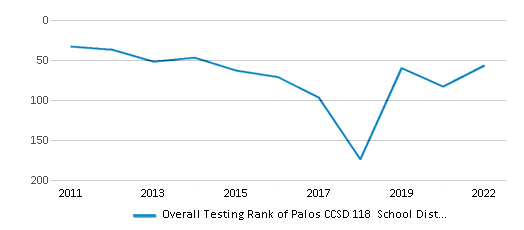
Math Test Scores (% Proficient)
(20-21)46%
28%
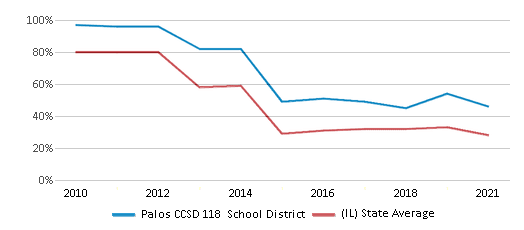
Reading/Language Arts Test Scores (% Proficient)
59%
30%
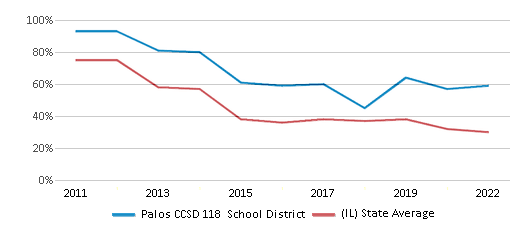
Science Test Scores (% Proficient)
75%
50%
Students by Ethnicity:
Diversity Score
0.41
0.71
# American Indian Students
1 Student
1,364 Students
% American Indian Students
n/a
n/a
# Asian Students
74 Students
32,125 Students
% Asian Students
4%
5%
# Hispanic Students
314 Students
185,771 Students
% Hispanic Students
15%
30%
# Black Students
52 Students
133,271 Students
% Black Students
2%
22%
# White Students
1,599 Students
244,693 Students
% White Students
76%
39%
# Hawaiian Students
4 Students
608 Students
% Hawaiian Students
n/a
n/a
# Two or more races Students
70 Students
23,281 Students
% of Two or more races Students
3%
4%
Students by Grade:
# Students in PK Grade:
79
19,756
# Students in K Grade:
185
27,178
# Students in 1st Grade:
217
28,250
# Students in 2nd Grade:
229
29,179
# Students in 3rd Grade:
255
29,629
# Students in 4th Grade:
216
30,553
# Students in 5th Grade:
230
38,342
# Students in 6th Grade:
248
109,327
# Students in 7th Grade:
231
135,557
# Students in 8th Grade:
226
137,502
# Students in 9th Grade:
-
9,488
# Students in 10th Grade:
-
9,079
# Students in 11th Grade:
-
8,909
# Students in 12th Grade:
-
8,526
# Ungraded Students:
-
-
District Revenue and Spending
The revenue/student of $19,819 in this school district is less than the state median of $21,990. The school district revenue/student has declined by 6% over four school years.
The school district's spending/student of $20,505 is less than the state median of $21,244. The school district spending/student has declined by 6% over four school years.
Total Revenue
$42 MM
$41,381 MM

Spending
$43 MM
$39,976 MM
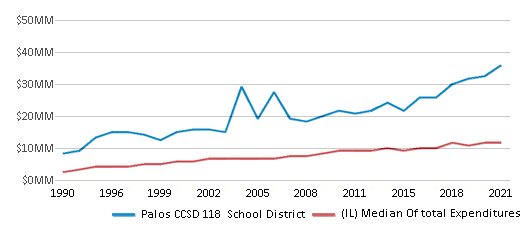
Revenue / Student
$19,819
$21,990

Spending / Student
$20,505
$21,244
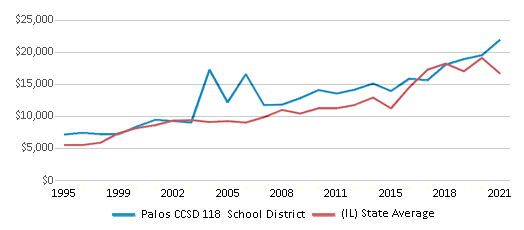
Best Palos CCSD 118 School District Public Middle Schools (2025)
School
(Math and Reading Proficiency)
(Math and Reading Proficiency)
Location
Grades
Students
Rank: #11.
Palos South Middle School
Rank:
10/
Top 10%10
13100 S 82nd Ave
Palos Park, IL 60464
(708) 448-5971
Palos Park, IL 60464
(708) 448-5971
Grades: 6-8
| 705 students
Recent Articles

Year-Round Or Traditional Schedule?
Which is more appropriate for your child? A year-round attendance schedule or traditional schedule? We look at the pros and cons.

Why You Should Encourage Your Child to Join a Sports Team
Participating in team sports has a great many benefits for children, there is no doubt. In this article you will learn what those benefits are.

White Students are Now the Minority in U.S. Public Schools
Increasing birth rates among immigrant families from Asia and Central and South America, combined with lower birth rates among white families, means that for the first time in history, public school students in the United States are majority-minority. This shift in demographics poses difficulties for schools as they work to accommodate children of varying language abilities and socio-economic backgrounds.





